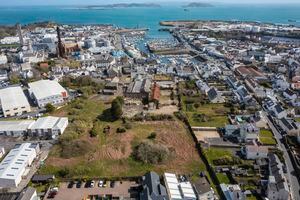Could we just start saying Yes?
After watching the Bridge fall apart over the last 20 years, is it too much to hope that the Leale’s Yard housing, parking and commercial development finally goes ahead? That the doubts remain says much about this island’s inability to get anything done, says Richard Digard

HERE’S a thought for you. Suppose someone came along and offered to build 330 new homes, provide 400 parking spaces, around 100,000sq. ft of land for commercial use, plus open green space with community and civic areas. How would you react? Bearing in mind that the offer, if accepted, included a 40,000sq. ft food and retail unit, infrastructure, roads, and facilities for what’s now known as active transport.
Since we’re talking Leale’s Yard here, and as someone who’s witnessed the slow decay of the Bridge area over the decades, my response is, ‘when do you start?’
That is not, however, a universally shared enthusiasm. And that’s incredibly frustrating. Which brings me on to the next question – how do you ever get anything done in Guernsey?
To watch the closet opposition to the proposals, especially to Policy and Resources’ intention to put £35m. into the project to secure key-worker homes, is to understand why the island is in such a state that even its most ardent supporter, Horace Camp, now describes it as waiting for God.
The problems are twofold. First is the red tape. I accept proper planning is a necessity and make no criticism of the authority. But the process now is incredibly bureaucratic, slow and expensive. The Co-op’s environmental impact assessment, without which nothing could happen, probably cost £500,000 alone, and has led to the relocation of two slow worms, some long-eared bats and a handful of white-toothed shrews. This is good for the wildlife, but less so for getting houses built.
The second is that everyone knows better than the States and the developer. Modular homes? Fire risk. Oh, and the company’s gone bust. Build at Leale’s Yard? Are you mad? Polluted site, riddled with toxins and chemicals.
Stand back a bit and you think, why would anyone spend money coming up with the scheme, preparing plans, applying for permissions and paying for an environmental assessment if the site was untouchable? (It isn’t, according to tests.)
To be clear, I have no interests in the site or the companies involved (other than having a Co-op share number) but I would like to see some life brought back to the Bridge – and, please god, a nice pub and restaurant – and don’t really care who does it.
The odd thing here, of course, is that the Co-op is historically responsible for the current state of the Bridge. Its ownership of the site and the years of delay in developing it has led to planning blight and the lack of investment which is so evident today, but not one of the people responsible for buying Leale’s Yard is now with the company.
All in all, you’d think there’d be more enthusiasm for getting on with a bit of regeneration, but it doesn’t always look that way. Perhaps it would be different if we still had parish deputies to lobby for it, because the Vale and St Sampson’s douzaines see the need for investment there, but even that reality check has now gone.
Instead, people look for reasons why something shouldn’t go ahead and the absence of joined-up government means it’s hard to prioritise or drive through. For instance, when Development and Planning was headed by Dawn Tindall she confirmed that it made more sense to press on with Leale’s Yard for housing, but that the States would probably go for Fontaine Vinery as it owned it. Why, for heaven’s sake? That’s just the way it is…
Well, that proposal seems to have stalled, as does the former Kenilworth Vinery, and P&R’s enthusiasm for cracking on with the Bridge scheme is because it offers the best prospect of delivering homes in any reasonable timescale. It also did quite a lot of research on the cost of the States employing agency staff and losing employees because of accommodation issues here, and swiftly concluded it made economic sense to invest in property of its own.
The other encouraging aspect of the proposals is the use of modular building techniques – the 330 homes are built off-island and simply erected here on pre-prepared foundations. Conventional building, I’m told, would need a workforce of around 150 tradespeople on site for three years to get the job done – if you could find them and house them.
TopHat, currently the favoured provider of modular homes after a beauty parade of six or so, can produce a unit an hour at its purpose-built factory, is backed by Goldman Sachs, Aviva and homebuilder Persimmons, and is 20% cheaper than conventional building.
That pedigree, Guernsey building control retaining sign-off and P&R running due diligence made suggestions of fire risk all the more surprising but highlights what I said earlier: we’re now better at coming up with reasons why something shouldn’t go ahead than focusing on how best to get it done.
In passing, if TopHat is used, the 15-tonne housing units will be shipped here via St Sampson’s and St Peter Port (because there are different sizes planned) and will need a 98-tonne-lift mobile crane to build the nine residential blocks of up to six storeys, which indicates some of the detailed planning that’s gone into the scheme.
There’s a wider interest in regenerating the Bridge, too. The States has forecast we need around 300 new homes a year, or an estimated 3,370 units by 2040, but with little chance of actually being able to build them.
If Leale’s Yard modular homes are a success, it will at least show that there are different ways of doing things which achieve quick results – about six apartments a day, I believe. The cost saving is also significant as building rates here are about 30% higher than on the south coast of the UK.
It’s worth noting, too, that the latest statistical digest from the States shows that there were just 165 new homes built in 2021, when we actually need around 300, which means that every year we’re falling further behind the housing target.
What happens next? If all goes to plan, an application to demolish the 18 or so derelict buildings at Leale’s Yard will be made. If approved, that will begin later this year, and a start can be made on the so-called Champs-Elysees, the main access road to the site. That will be punched through the old charity shops opposite the North Side roundabout, which will eventually be replaced with traffic lights.
As you can see, planning is well advanced on something that we desperately need and which P&R wants to happen to resolve some of the States’ own issues. The fact that it’s not guaranteed, despite all the positives, tells you much about the obstacles we now put in the way of getting anything done here at all.





